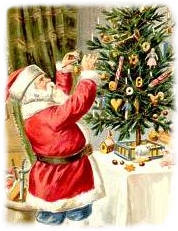I took this from a website on Germany's Christmas Markets. enjoy! Photos of my own visits with my mother will be posted on here soon I am sure. :-)
The History of German Christmas Markets
 Each year Christmas Markets spring up around Germany in the weeks before the Christmas holidays, signalling the beginning of Advent.
Each year Christmas Markets spring up around Germany in the weeks before the Christmas holidays, signalling the beginning of Advent.
The centuries-old tradition reaches back to a time when regular seasonal markets took place throughout the year. Christmas markets were a welcome occurrence during cold-weather months. They were joyful occasions for weary villagers and added a bit of light to long winter nights.
The first markets were little more than winter markets that lasted a couple of days. Instead of the cosy stands that line market alleys today, traders in some cities laid their goods out in the streets.
Through the years, each market has stayed  true to its own particularities, with each specializing on local delicacies and traditional products. In the past, only local tradesmen were allowed to sell their wares at the city’s market, which led to the distinctive regional character of today’s markets.
true to its own particularities, with each specializing on local delicacies and traditional products. In the past, only local tradesmen were allowed to sell their wares at the city’s market, which led to the distinctive regional character of today’s markets.
Today, German Christmas markets serve much the same function that they have for centuries — as a festive meeting place for locals and a market for homemade Christmas ornaments and decorations.
Some of the most traditional German handicrafts can be found here in the weeks before Christmas — from nutcrackers, wooden figurines, straw stars and smokers, to cookie tins, glass balls, toys, and tin tree ornaments.
Despite the widespread belief that Christmas has only recently developed into a feast of commercialism, it may be shocking to find out that, as early as the 17th century, gift-buying at Christmas Markets had already become a main pre-holiday activity.
 Usually, the Christmas markets were held around the city’s main church to attract church-goers. But they were so enticing that a priest in Nürnberg in 1616 complained that he could not hold the afternoon service on Christmas Eve because no one attended.
Usually, the Christmas markets were held around the city’s main church to attract church-goers. But they were so enticing that a priest in Nürnberg in 1616 complained that he could not hold the afternoon service on Christmas Eve because no one attended.
It is likely that the markets drew more visitors when religious reformer Martin Luther instituted new customs for Christmas. Before Luther, the exchanging of presents took place on the saint days of St. Nicholas, December 6, or of St. Martin, on November 11.
It was Luther who suggested that children receive presents from “the Christ child,” hence the name “Christkindlsmarkt,” a popular name for the Christmas Markets in Germany.
![]()

And I am so happy to be able to go with you to the Weinachts Markdt (or however it is spelled!)
ReplyDeleteIt you go visit Melissa at this time of year, ...be sure to dress warmly! As soon as the sun goes down, it is COLD! Loved it, MOM